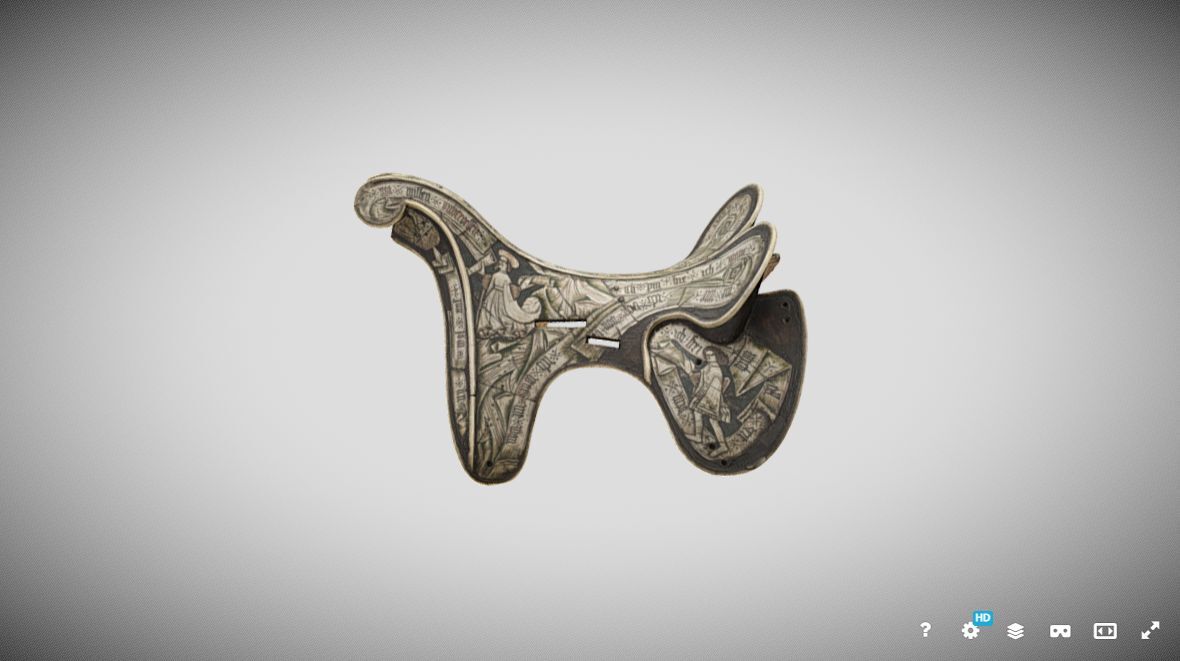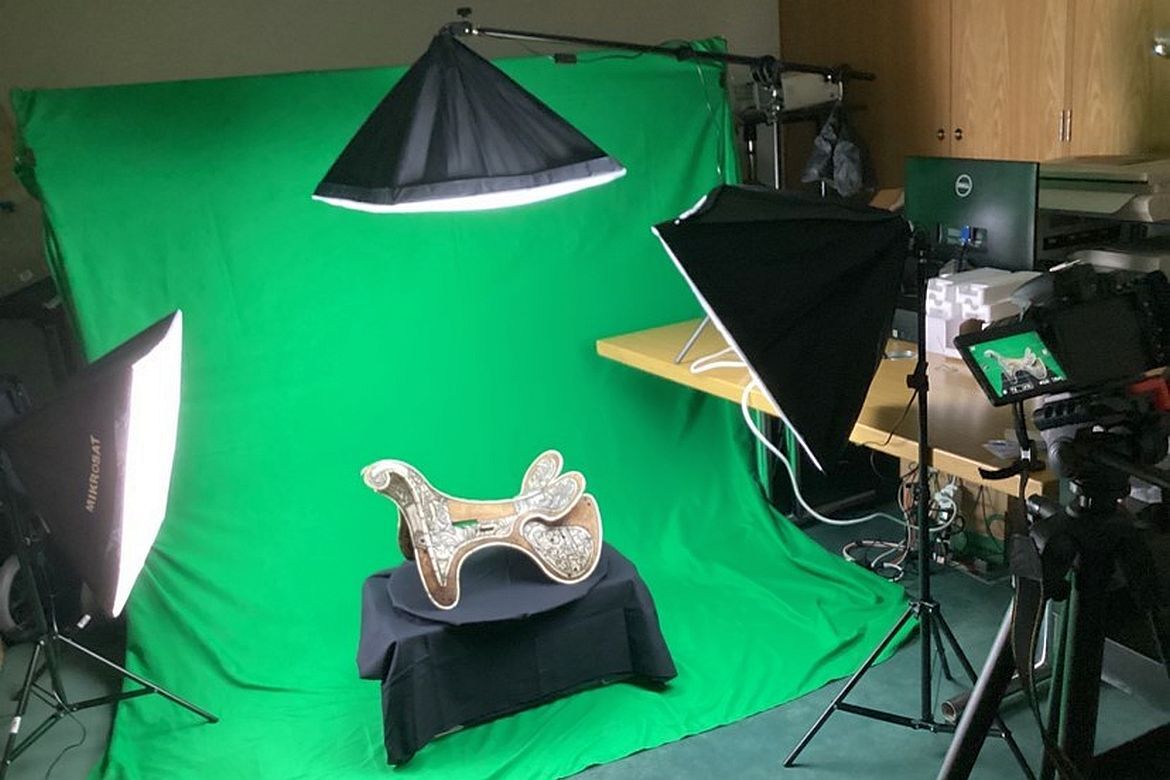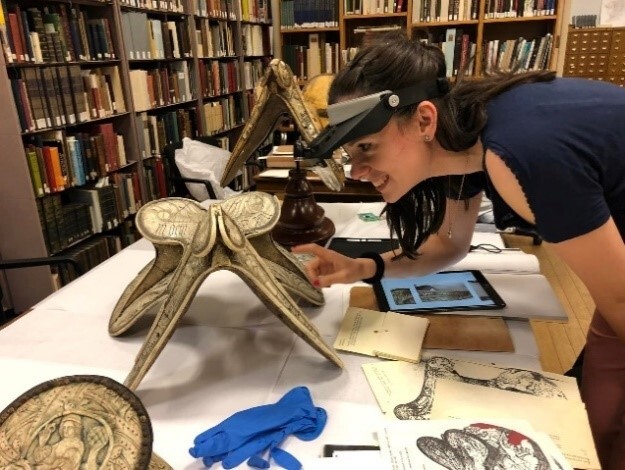In a recent digitization project at the Institute of Art History, three-dimensional digital models of late medieval bone saddles were created using photogrammetry. The models were made by Virág Somogyvári, Junior Research Fellow at the Institute of Art History.
Five bone saddles were digitized as part of the project, including:
- A 407 and A 408 of the Wallace Collection, London;
- E 1939.65.bx bone saddle of the Kelvingrove Art Gallery and Museum of Glasgow
- A 64 and A 73 bone saddles of the Kunsthistorisches Museum, Hofjagd- und Rüstkammer, Vienna.

Bone Saddle, The Wallace Collection (A 408)
The aim of the project
The research framework for the project is a Ph.D. dissertation on late medieval bone saddles, currently in progress. Most of the 37 pieces in the object group date from the 15th century and are now in museums in Europe and the United States. In the 19th and 20th centuries, they were part of prominent European art collections. The thin bone plates covering the entire surface of the saddle trees are decorated with carvings revealing a rich iconographic program, with motifs of love symbolism.
The main goal of the project was to improve the research possibilities related to bone saddles. Due to their elaborate and complex shape, their precise examination is only possible during an autopsy. Examination from photographs is limited, as 2D images do not provide full visibility of all the sides and views of the objects. A three-dimensional model, however, can be rotated in all directions, making it much easier to examine the surface of the object. Furthermore, since late medieval bone saddles are currently in various museums, the comparative analysis using traditional photography is limited to the parts that are only visible in the photographs.
Therefore, three-dimensional models can open new perspectives in the study of bone saddles, which will greatly facilitate research in both technical, and surface examination of the saddles, and comparative studies. Moreover, the construction of a model promises additional perspectives. Printing a model of a bone saddle with a 3D printer or fabricating it using CNC technology also offers possibilities that may not even be considered for fragile artifacts locked behind display cases. Such a reproduction, created using this non-traditional method, can be tested in practice, which can answer several questions: How well does the saddle fit on a horse's back, and is it even practical to use?
Workflow
The greatest advantage of photogrammetric digitizing is that it only requires a DSLR camera, proper lighting equipment, photogrammetric software, and a powerful computer. Unlike using expensive laser scanners, this is a cost-effective way to create high-quality models using a relatively easily transportable set of tools.
The method of photogrammetry requires taking as many overlapping photographs of the object as possible. The photogrammetry software uses these to calculate the position of the environment and the camera. By combining and comparing the angles, it calculates the three-dimensional data and identifies the points of the adjacent photos. It then reconstructs the three-dimensional structure of the objects and the environment in the photos, which it stores in a point cloud. The next step is to generate a mesh based on this, which is a model composed of polygons. Textures can then be superimposed on this mesh, which are generated by merging the texture data extracted from the photos.
 On-site photo of the Wallace Collection, London, during the photo shoot of A 407 bone saddle, May 26, 2022. Photo by the author.
On-site photo of the Wallace Collection, London, during the photo shoot of A 407 bone saddle, May 26, 2022. Photo by the author.
The first step in the photogrammetric digitization of the bone saddles was to take photographs. To do this, the saddle was placed on a turntable and photographed 360 degrees, manually rotating it by an angle every 1-2 centimeters. The photos were taken from a total of four levels, and then from three more levels by turning the object upside down. In total, about 600 photos were taken of one saddle.
 Flowchart for photographing the bone saddles
Flowchart for photographing the bone saddles
After the photo shoot, post-processing followed. First, the correct color settings were made and the images were arranged, and then the editing of the photos in the software began. The Agisoft Metashape software creates the 3D model more or less automatically. However, numerous factors require manual post-processing. One of those factors is that being a museum object they require special treatment. A slowing factor was that the inverted saddle had to be placed on a soft surface material to protect the object. This material could only be removed by manual cutting during software post-processing. In addition, due to the bone saddles' complex shape and curved surfaces, many other post-processing operations and 'clean-ups' were required. For reasons of artifact protection, the facilitations and tricks used for ordinary objects were not applicable to bone saddles. Temporary treatment of glossy surfaces and the application of matt paint during the photo shoot, for example, were not possible. Therefore, the minimal gloss of the birch bark-coated surface of the inside of the bone saddles was initially a concern for the success of the model. In addition, there was also the question of how much the shadow cast by the cantles on the lower part of the saddle would affect the model and whether it would be visible in the final model. Other major challenges mas manually cutting out the rectangular holes for the girth and the stirrup leathers and the small round holes for attaching the saddle.
 A 408 bone saddle from the Wallace Collection in London. Phase photos: a) single photo example, b) point cloud representation c) 3D mesh. Image by the author.
A 408 bone saddle from the Wallace Collection in London. Phase photos: a) single photo example, b) point cloud representation c) 3D mesh. Image by the author.
Results
The three-dimensional reproductions were successfully performed and models were created that can be freely rotated in any direction. The textures of the models are of relatively good quality and the different materials (wood, bone, leather) are identifiable and distinguishable from each other. However, the result is not as sharp as a close-up detail photo, and at high magnification the result is blurred. The quality can be improved in the future by using a higher category fixed lens or by integrating close-up detail photos into the software. Thus, at this stage of the project, the hybrid method, using the model and two-dimensional detail photos together is the optimal way to examine the object. Another experience with the models is that the details of finer reliefs are not perceptible in space but only appear as flat surfaces.
The creation of three-dimensional models is therefore primarily a tool for the study of carvings and structures, as well as for comparative analysis. In addition, the practical use of 3D models can be of great benefit, whether they are used for 3D printing or CNC technology to produce physical replicas, or even to facilitate the production of traditional saddle reconstructions based on the models. The physical replicas produced are useful for research purposes and may be used in the future for exhibitions and educational purposes in close cooperation with museums.
The project was made possible by the Isabel and Alfred Bader Art History Research Fellowship and the IT and Peregrination Grants from the Institute of Art History of the Research Centre for the Humanities.
The published models are available on the Sketchfab page of the Research Centre for the Humanities: https://sketchfab.com/researchcentreforthehumanities
Virág Somogyvári  is a Junior Research Fellow at the Institute of Art History of the Research Centre for the Humanities and a Ph.D. student at the Doctoral School of History of the Pázmány Péter Catholic University.
is a Junior Research Fellow at the Institute of Art History of the Research Centre for the Humanities and a Ph.D. student at the Doctoral School of History of the Pázmány Péter Catholic University.
Her research area and doctoral topic is the interdisciplinary study of bone saddles from the late Middle Ages.
Her main focus is on the original function, style, iconographic program, cultural context, and reception history of the saddles. She is also working on compiling a complete corpus of the bone saddles known today.


